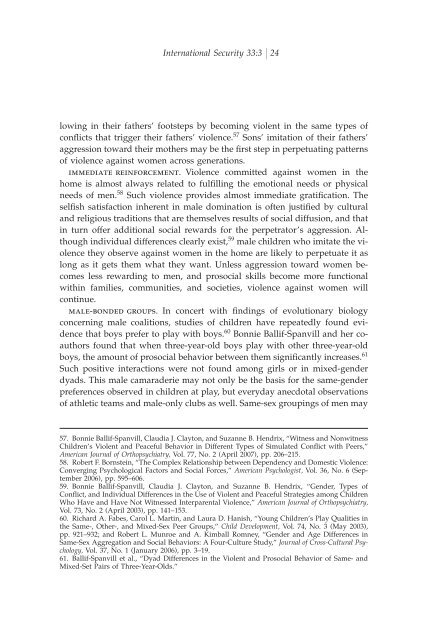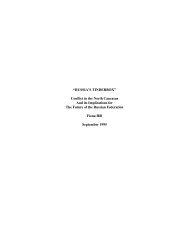The Heart of the Matter Valerie M. Hudson, - MIT Press Journals
The Heart of the Matter Valerie M. Hudson, - MIT Press Journals
The Heart of the Matter Valerie M. Hudson, - MIT Press Journals
Create successful ePaper yourself
Turn your PDF publications into a flip-book with our unique Google optimized e-Paper software.
International Security 33:3 24<br />
lowing in <strong>the</strong>ir fa<strong>the</strong>rs’ footsteps by becoming violent in <strong>the</strong> same types <strong>of</strong><br />
conºicts that trigger <strong>the</strong>ir fa<strong>the</strong>rs’ violence. 57 Sons’ imitation <strong>of</strong> <strong>the</strong>ir fa<strong>the</strong>rs’<br />
aggression toward <strong>the</strong>ir mo<strong>the</strong>rs may be <strong>the</strong> ªrst step in perpetuating patterns<br />
<strong>of</strong> violence against women across generations.<br />
immediate reinforcement. Violence committed against women in <strong>the</strong><br />
home is almost always related to fulªlling <strong>the</strong> emotional needs or physical<br />
needs <strong>of</strong> men. 58 Such violence provides almost immediate gratiªcation. <strong>The</strong><br />
selªsh satisfaction inherent in male domination is <strong>of</strong>ten justiªed by cultural<br />
and religious traditions that are <strong>the</strong>mselves results <strong>of</strong> social diffusion, and that<br />
in turn <strong>of</strong>fer additional social rewards for <strong>the</strong> perpetrator’s aggression. Although<br />
individual differences clearly exist, 59 male children who imitate <strong>the</strong> violence<br />
<strong>the</strong>y observe against women in <strong>the</strong> home are likely to perpetuate it as<br />
long as it gets <strong>the</strong>m what <strong>the</strong>y want. Unless aggression toward women becomes<br />
less rewarding to men, and prosocial skills become more functional<br />
within families, communities, and societies, violence against women will<br />
continue.<br />
male-bonded groups. In concert with ªndings <strong>of</strong> evolutionary biology<br />
concerning male coalitions, studies <strong>of</strong> children have repeatedly found evidence<br />
that boys prefer to play with boys. 60 Bonnie Ballif-Spanvill and her coauthors<br />
found that when three-year-old boys play with o<strong>the</strong>r three-year-old<br />
boys, <strong>the</strong> amount <strong>of</strong> prosocial behavior between <strong>the</strong>m signiªcantly increases. 61<br />
Such positive interactions were not found among girls or in mixed-gender<br />
dyads. This male camaraderie may not only be <strong>the</strong> basis for <strong>the</strong> same-gender<br />
preferences observed in children at play, but everyday anecdotal observations<br />
<strong>of</strong> athletic teams and male-only clubs as well. Same-sex groupings <strong>of</strong> men may<br />
57. Bonnie Ballif-Spanvill, Claudia J. Clayton, and Suzanne B. Hendrix, “Witness and Nonwitness<br />
Children’s Violent and Peaceful Behavior in Different Types <strong>of</strong> Simulated Conºict with Peers,”<br />
American Journal <strong>of</strong> Orthopsychiatry, Vol. 77, No. 2 (April 2007), pp. 206–215.<br />
58. Robert F. Bornstein, “<strong>The</strong> Complex Relationship between Dependency and Domestic Violence:<br />
Converging Psychological Factors and Social Forces,” American Psychologist, Vol. 36, No. 6 (September<br />
2006), pp. 595–606.<br />
59. Bonnie Ballif-Spanvill, Claudia J. Clayton, and Suzanne B. Hendrix, “Gender, Types <strong>of</strong><br />
Conºict, and Individual Differences in <strong>the</strong> Use <strong>of</strong> Violent and Peaceful Strategies among Children<br />
Who Have and Have Not Witnessed Interparental Violence,” American Journal <strong>of</strong> Orthopsychiatry,<br />
Vol. 73, No. 2 (April 2003), pp. 141–153.<br />
60. Richard A. Fabes, Carol L. Martin, and Laura D. Hanish, “Young Children’s Play Qualities in<br />
<strong>the</strong> Same-, O<strong>the</strong>r-, and Mixed-Sex Peer Groups,” Child Development, Vol. 74, No. 3 (May 2003),<br />
pp. 921–932; and Robert L. Munroe and A. Kimball Romney, “Gender and Age Differences in<br />
Same-Sex Aggregation and Social Behaviors: A Four-Culture Study,” Journal <strong>of</strong> Cross-Cultural Psychology,<br />
Vol. 37, No. 1 (January 2006), pp. 3–19.<br />
61. Ballif-Spanvill et al., “Dyad Differences in <strong>the</strong> Violent and Prosocial Behavior <strong>of</strong> Same- and<br />
Mixed-Set Pairs <strong>of</strong> Three-Year-Olds.”
















